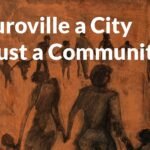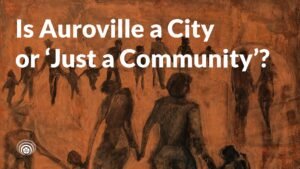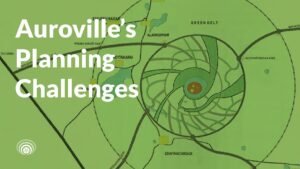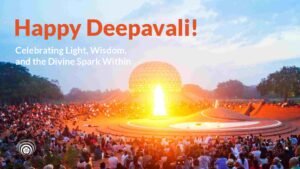
The 2025 Supreme Court Verdict as a Catalyst for Conscious Becoming
In April 2025, the Supreme Court of India delivered a decisive judgment in favor of the Auroville Foundation, bringing to a close a long-standing legal dispute over the implementation of the Auroville Master Plan. By setting aside the earlier National Green Tribunal order, the Court reaffirmed the statutory validity of the Master Plan and clarified the overriding authority of the Auroville Foundation Act, passed by the Indian Parliament.
For many, this ruling came as a long-awaited validation—a legal acknowledgment of the Mother’s vision for a planned, harmonious city dedicated to human unity and evolution. For others, it felt like a painful loss—a marginalization of ecological sensitivities, participatory governance, and the slow, organic rhythm by which Auroville had grown over the decades.
Yet this moment must not be seen solely through the lens of victory or defeat. It must be understood more deeply—as a transitional clearing in Auroville’s unfolding evolutionary journey. If we stop at the legal resolution, we may miss the greater invitation that this moment holds: not merely to implement a plan, but to embody a consciousness.
The Verdict as Clearing
The Supreme Court was unequivocal in its stance. It ruled that no substantial environmental question had been raised under the NGT Act’s Schedule I and held that the Master Plan, having been approved by the Government of India, carries statutory authority. It also reaffirmed that the Auroville Foundation Act takes precedence over other laws in cases of inconsistency.
This brings legal clarity after years of procedural confusion and contestation. But legal clarity is not the same as collective clarity. The Master Plan may now move forward, but the spirit in which it moves will determine whether it fulfills or betrays the aspiration at Auroville’s heart.
Beyond Legal Victory
Auroville was not founded merely as a civic project or ecological settlement. It was—and remains—a spiritual experiment in human unity, conceived by the Mother as a place where the future of consciousness could be consciously worked out in matter. This vision does not belong to any one group, department, or interpretation. It transcends factions.
The legal judgment may settle the question of jurisdiction. But it cannot resolve the deeper tension between modes of becoming—between centralized authority and organic self-organization, between visionary planning and ground-level adaptability, between structure and spirit.
In Sri Aurobindo’s words, “all problems of existence are essentially problems of harmony.” The challenge before Auroville is to rise beyond polarities and discover a deeper synthesis—not through compromise, but through a shared effort to serve the evolutionary goal.
The Chrysalis Phase
The metaphor that suits this phase is of the chrysalis, which is apt. In the life cycle of a butterfly, the chrysalis is not simply a waiting room—it is a crucible of transformation. The caterpillar dissolves. Its old self is broken down, and from that dissolution, the seeds of the new form begin to take shape.
Auroville today is in such a phase. The conflict, pain, and polarization of recent years have not been meaningless. They have acted as catalysts, exposing unspoken tensions, revealing fault lines, and bringing into the light the deeper questions that have always lurked beneath the surface: What is Auroville’s real purpose? Who decides its direction? How do we hold fidelity to the original vision while evolving in real time?
The Supreme Court’s ruling does not end this transformation. It offers a pause—a still point in a turbulent process. But it cannot dictate what Auroville becomes next. That choice belongs to the residents, stewards, dreamers, and doers who inhabit this space—not in opposition, but in co-creation.
From Fracture to Healing
The wounds of the recent years are real. Relationships have frayed. Trust has eroded. Narratives have hardened into echo chambers. There is no legal ruling that can repair this fracture.
Healing must now become the work of the community. And healing does not mean forgetting. It means integrating. Recognizing that those who opposed development were not enemies of progress—but often protectors of scale, ecology, and process. And those who supported the Master Plan were not villains of nature—but often guided by their fidelity to the vision the Mother entrusted to Auroville.
The way forward is not through accusations, but through listening. Not through dominance, but through mutuality. Not through passive coexistence, but through conscious collaboration.
Integral Development
One of the dangers ahead is mistaking the legal green light for a license to proceed mechanically. That would be a betrayal of both the letter and the spirit of Auroville.
The Master Plan is not a checklist. It is a skeletal structure waiting to be animated by spirit. Roads, buildings, infrastructure—all of these are means, not ends. Their legitimacy lies not in their completion, but in the consciousness with which they are created.
The Supreme Court rightly noted the need to balance ecological preservation with the right to development. But in Auroville, that balance must be more than regulatory. It must be integral—psychological, spiritual, social. Development here must emerge not from the world’s norms but from Auroville’s soul. The Crown Road must not become a circle of division. It must become a symbol of integration—a pathway around which community, creativity, and consciousness converge.
Evolution Beyond Opposition
If we zoom out from this single judgment, a larger pattern becomes visible. Humanity, too, is in a chrysalis phase. Crises multiply. Systems strain. Polarities intensify. But beneath it all, a new consciousness is trying to emerge. Sri Aurobindo described this as the supramental transformation—the next step in human evolution.
Auroville was built to be the ground for that experiment. It cannot fulfill this role by clinging to safety or descending into factionalism. It can only do so by rising, again and again, to its highest possibility.
This will require:
- Transparent and inclusive processes that rebuild trust
- Development grounded in inner alignment, not just outer authority
- A recommitment to the Auroville Charter as a living guidance—not a historical artifact
It will also require humility. The recognition that we are all instruments of something greater—that no group, ideology, or plan can encompass the whole truth.
A Living Beginning
It is tempting to see this judgment as the end of a conflict. But it is far more important to see it as the beginning of a deeper responsibility. The law has spoken. But Auroville’s inner voice must now respond.
The future of this city will not be determined by courtrooms, blueprints, or mandates alone. It will be shaped by the quality of our consciousness—by whether we can embody unity in the face of division, stillness in the face of turmoil, aspiration in the face of cynicism. The chrysalis phase is not over. But it has reached a turning point. The wings of the future are forming. Let us not interrupt the process. Let us have the courage to stay with the transformation. The patience to wait. The faith to act. And the grace to fly.






